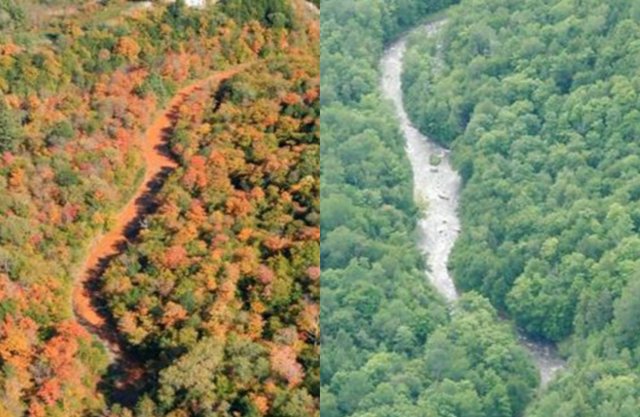Sustainable Treatment System Caps Off Cleanup at Elizabeth Mine Superfund Site
Published March 19, 2024
Interwoven into the stunning fabric of Vermont’s natural beauty lies the remains of the Elizabeth Copper Mine. The mine is situated in the heart of the Vermont Copper Belt and is composed of massive, copper-rich sulfide deposits. The mine is surrounded by woods, undeveloped properties and residential properties.
Elizabeth Mine is one of several mines that were abandoned in 1958, leaving about 80 acres of exposed waste rock and tailing – the leftover materials from mining. These waste piles discharged contamination into local water bodies, affecting aquatic life in the West Branch of the Ompompanoosuc River, and leading the river to be listed on EPA’s impaired waters list. As a result, EPA added Elizabeth Mine to the Superfund National Priorities list in 2001, which identifies abandoned, highly toxic waste sites in the United States, and prioritizes them for long-term cleanup from hazardous contamination.

In 2001, EPA began implementing cleanup at Elizabeth Mine. During early efforts, a local dam near the site was on the verge of collapse. EPA Remedial Project Manager Ed Hathaway, On-Scene Coordinator Wing Chau from EPA Region 1 (New England), and a team of EPA Superfund experts were able to take planned, time critical action measures to stabilize and reinforce the dam. This included providing stand-by pumps to increase extra drainage capacity when snow melted in Spring 2003.
EPA’s Barbara Butler, a research environmental engineer, joined Hathaway and the team of Superfund experts in 2007 to support EPA’s multi-phased, non-time critical removal action efforts already in place at Elizabeth Mine site. Butler, Hathaway, and the team contributed knowledge, expertise, and experience with on-site Superfund cleanup and removal of contaminants from acid mine drainage at the site.
A major component of the cleanup was an innovative water treatment system called the Rotating Cylinder Treatment System (RCTS™). The RCTS™ was chosen due to its smaller footprint and lesser amounts of lime (calcium oxide) required to treat the high concentration of iron discharging from the tailing impoundment as compared to conventional lime treatment systems.
By 2018, the iron concentration in the waste discharging from the tailing impoundment had been sufficiently decreased. This allowed EPA to look for a more sustainable method of treatment.
EPA’s Butler worked closely with EPA Region 1, the Vermont Department of Environmental Conservation, and site consultants to develop an innovative passive treatment system that uses limestone beds, open settling ponds, vertical flow pond, and treatment wetlands to clean the water without any electrical power.
The team began installing the passive treatment system in October 2018 and it was completed in June 2019. The system has a level of redundancy that allows various components to be off-line and still achieve cleanup objectives.
Data collected through June 2023 has shown that the passive treatment system is effectively removing iron from the leachate to meet the state’s water quality criterion.
“I’ve enjoyed being a part of the team to develop and assess performance of this system,” Butler said. “Passive treatment relies on microbial and chemical processes. One of the common concerns expressed regarding passive treatment is whether the microbial processes would be effective under cold temperatures. It is great to see a successful passive treatment system in a cold climate and I am looking forward to continued monitoring to assess longer-term performance that can be shared with other remedial project managers, and remediation practitioners to perhaps encourage more use of passive treatment at other sites.”
When reflecting on Butler’s major contributions, Hathaway noted, “Barb is a great resource and example of the contributions that EPA researchers can bring to a project team. She brings her technical knowledge and experience working at many sites to provide value added input and critical thinking to the project team. Adding the vertical flow pond was just one example of her substantial contributions. This component of the system allows successful treatment to occur even when the anoxic limestone drain is offline and adds the additional treatment to ensure success during the cold weather months.”
This cleanup was a team effort combining the expertise of EPA national and regional staff, including the EPA National Mining Team, other federal agencies (United States Geological Survey and United States Army Corps of Engineers), expert consultants and construction companies, and the State of Vermont Agency of Natural Resources to solve complex problems at abandoned mine sites. The site’s adaptive approach targeted the worst threats first (potential tailing dam failure) and then integrated aggressive source control measures along with effective interim treatment measures to achieve cleanup success. Once the contaminant concentrations and flow were reduced, the team was able to transition cleanup efforts to a sustainable, greener, long-term passive treatment system.
Work efforts during the initial phases of treatment created an opportunity for EPA to repurpose treated land at the site into a solar field that is now home to a 20,000-panel solar array. The 5-megawatt installation went online in 2017 and powers 1,200 homes a year. Initially working with 8 acres of toxic wetlands at the site, EPA ultimately revitalized a total of 15 acres to healthy wetlands.
This work is representative of how EPA researchers are collaborating with other experts to solve some of our most difficult environmental cleanups across the nation.
Learn More
Superfund Sites in Reuse in Vermont
Land and Waste Management Research
Editor’s Note: Any mention of trade names, products, or services does not imply an endorsement by the U.S. Government or the U.S. Environmental Protection Agency. The EPA does not endorse any commercial products, services, or enterprises.
